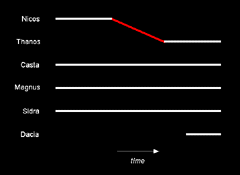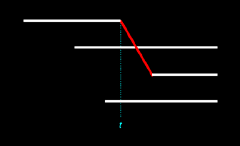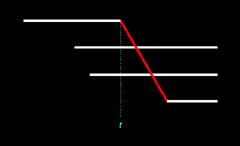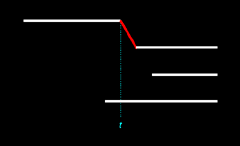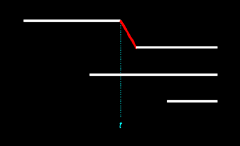
|
Chapter 14 Ex Nihilo Probability |
|
In the previous chapter we determined that
a person encountering existential passage would be three times as
likely to experience a merged passage as a unitary passage. Now we can turn
our attention to the recipient of the existential
passage.
Not all newborns are thought to receive passages under Metaphysics by
Default. As we've seen previously in Figure 11.6, a newborn can appear at a time when no passage participant (i.e., no ending terminus) is available.
Figure 11.6 is
printed again below as Figure 14.1. In this figure Dacia (at bottom)
receives no existential passage:
|
|
Continuing our
mathematical analysis from the previous chapter, we now ask: How likely is ex nihilo passage, relative to participated passage? We can
use the same probability technique developed in the previous chapter to find an
informal answer to this new question. As before, a formal answer does
also exist. The formal derivation is located in
Appendix A.
The simplest scenario is this:
a person has been born into a simple cosmos, and
thereafter has passed away at some time
t. We
"freeze" that person's timeline in Figure 14.2. We'll assume that it
cannot be altered, and that for now it represents the only life that has existed
in the cosmos.
|
|
In figure 14.2 we see that this person, being the only person extant in his cosmos, must have been born as an ex nihilo passage. This is certain. We will denote this probability as pex1, thus: pex1 = 1
where pex n stands for the relative probability of n persons being born into ex
nihilo passage.
Now we add a
second person, a potential recipient of that first person's existential
passage. The timing of the birth of this second person we will consider to be
random. This potential recipient may be born at any time, either before or
after time t, unpredictably. The two possible
types of outcomes are illustrated in the following two figures:
|
|
In Figure 14.3 we see that both of the illustrated births are ex nihilo passages. However, this is not the case in Figure 14.4, wherein only one birth is an ex nihilo passage. Since each of these two outcomes is equally likely, the probability that all births will be ex nihilo passages is here 1/2, or 0.5. We denote this probability as pex2: pex2 = 0.5
What if we add a third birth to the
scenario? We can create another set of figures to determine the
probability that all three births will be ex nihilo passages. Again, the random births
we've added may occur at any time, either before or after time t. Four outcomes are now possible:
|
|
Only in Figure 14.5 are all three births ex nihilo passages. Since each of the four outcomes is equally likely, the probability that all births will be ex nihilo passages is here 1/4, or 0.25. pex3 = 0.25
What if we add a fourth birth to the
scenario? We can create another set of figures to determine the
probability that all four births will be
ex nihilo passages. Again, the random births
we've added may occur at any time, either before or after time t. Eight outcomes are now possible:
|
|
pex4 = 0.125
A progression of relative
probabilities for each n-tuple group of
ex nihilo passages is emerging, according to the rule:
pex n = (1/2)n-1 {
n = 1 to infinity }
where, again, n
is the number of newborns experiencing ex nihilo
passage.
Let's recall from
Chapter 13 our very first attempt at a probability
rule. We came up with a rule for determining the relative probability of
each n-to-one passage type:
pn = (1/2)n-1 {
n = 1 to infinity }
This rule is identical to the relative
probability rule predicting the occurrence of n ex
nihilo passages:
pex n = (1/2)n-1 {
n = 1 to infinity }
Stated as a
ratio: Newborns' experienced ratio of ex
nihilo passage, relative to participated passage, would be 1:1.
next Chapter 15: Noetic Reduction |
|
|
Copyright © 1999
Wayne Stewart
Last update 4/19/11
